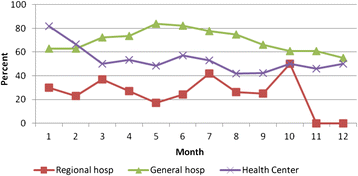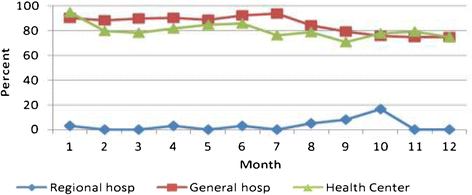Adherence to standards of quality HIV/AIDS care and antiretroviral therapy in the West Nile Region of Uganda
- PMID: 25399661
- PMCID: PMC4239403
- DOI: 10.1186/s12913-014-0521-5
Adherence to standards of quality HIV/AIDS care and antiretroviral therapy in the West Nile Region of Uganda
Abstract
Background: Over one million people in Uganda are estimated to be infected with HIV and about 20% of these were already accessing antiretroviral therapy (ART), by 2010. There is a dearth of data on adherence to antiretroviral therapy and yet high client load on a weak and resource constrained health system impacts on provision of quality HIV/AIDS care. We assessed adherence to standards of HIV care among health workers in the West Nile Region of Uganda.
Methods: We conducted a cross sectional study in nine health facilities. Records of a cohort of 270 HIV clients that enrolled on ART 12 months prior were assessed. The performance of each health facility on the different indicators of standards of HIV/AIDS care was determined and compared with the recommended national guidelines.
Results: We found that 94% of HIV clients at all the facilities were assessed for ART eligibility using WHO clinical staging while only two thirds (64.8%) were assessed using CD4. Only 42% and 37% of HIV clients at district hospitals and health centers respectively, received basic laboratory work up prior to ART initiation and about a half (46.7%) of HIV clients at these facilities received the alternative standard 1st line antiretroviral (ARV) regimen. Standards of ART adherence and tuberculosis assessment declined from over 70% to less than 50% and from over 90% to less than 70% respectively, during follow up visits with performance being poorer at the higher level regional referral facility compared to the lower level facilities.
Conclusions: Adherence to standards of HIV/AIDS care at facilities was inadequate. Performance was better at the start of ART but declined during the follow up period. Higher level facilities were more likely to adhere to standards like CD4 monitoring and maintaining HIV clients on standard ARV regimen. Efforts geared towards strengthening the health system, including support supervision and provision of care guidelines and job aides are needed, especially for lower level facilities.
Figures
Similar articles
-
Quality standards in provision of facility based HIV care and treatment: a case study from Dar es Salaam Region, Tanzania.East Afr J Public Health. 2007 Apr;4(1):12-8. East Afr J Public Health. 2007. PMID: 17907755
-
Are health workers reduced to being drug dispensers of antiretroviral treatment? A randomized cross-sectional assessment of the quality of health care for HIV patients in northern Uganda.Health Policy Plan. 2019 Oct 1;34(8):559-565. doi: 10.1093/heapol/czz074. Health Policy Plan. 2019. PMID: 31408152 Free PMC article.
-
API consensus guidelines for use of antiretroviral therapy in adults (API-ART guidelines). Endorsed by the AIDS Society of India.J Assoc Physicians India. 2006 Jan;54:57-74. J Assoc Physicians India. 2006. PMID: 16649742 Review.
-
Adoption of new HIV treatment guidelines and drug substitutions within first-line as a measure of quality of care in rural Lesotho: health centers and hospitals compared.Trop Med Int Health. 2012 Oct;17(10):1245-54. doi: 10.1111/j.1365-3156.2012.03051.x. Epub 2012 Jul 29. Trop Med Int Health. 2012. PMID: 22845835
-
Performance and trend for quality of service in a large HIV/AIDS treatment program in Nigeria.AIDS Res Ther. 2019 Oct 1;16(1):29. doi: 10.1186/s12981-019-0242-2. AIDS Res Ther. 2019. PMID: 31575377 Free PMC article. Review.
Cited by
-
Capacity of health facilities for diagnosis and treatment of HIV/AIDS in Ethiopia.BMC Health Serv Res. 2018 Jul 11;18(1):535. doi: 10.1186/s12913-018-3347-8. BMC Health Serv Res. 2018. PMID: 29996821 Free PMC article.
-
Adherence to antiretroviral and cancer chemotherapy, and associated factors among patients with HIV-cancer co-morbidity at the Uganda Cancer Institute: a cross sectional study.BMC Public Health. 2023 Jul 28;23(1):1451. doi: 10.1186/s12889-023-16387-z. BMC Public Health. 2023. PMID: 37507710 Free PMC article.
-
Evaluation of the effect of an educational intervention on knowledge and adherence to HIV guidelines among frontline health workers in Alex-Ekwueme Federal University Teaching Hospital Abakaliki, Nigeria.Afr Health Sci. 2020 Sep;20(3):1080-1089. doi: 10.4314/ahs.v20i3.10. Afr Health Sci. 2020. PMID: 33402953 Free PMC article.
-
Quality of antiretroviral therapy services in Ghana: Implications for the HIV response in resource-constrained settings.SAGE Open Med. 2021 Jul 31;9:20503121211036142. doi: 10.1177/20503121211036142. eCollection 2021. SAGE Open Med. 2021. PMID: 34377475 Free PMC article.
-
Antiretroviral Therapy Service Quality and Associated Factors at Selected Public Hospitals, Addis Ababa, Ethiopia, 2021.HIV AIDS (Auckl). 2022 Mar 25;14:129-142. doi: 10.2147/HIV.S348254. eCollection 2022. HIV AIDS (Auckl). 2022. PMID: 35370425 Free PMC article.
References
-
- United Nations AIDS (UNAIDS) Global HIV/AIDS Response-Epidemic Update and Health Sector Progress Towards Universal Access-Progress Report. Geneva: United Nations AIDS (UNAIDS); WHO; 2011.
-
- Ministry of Health STD/AIDS Control Program 2009 . The HIV/AIDS Epidemiological Surveillance Report 2005–7 June. Kampala, Uganda: MOH; 2009. Status of the HIV/AIDS Epidemic in Uganda.
-
- World Health Organization . Standards for Quality HIV Care: A Tool for Quality Assessment, Improvement and Accreditation. Geneva: WHO; 2004.
-
- World Health Organization . Antiretroviral Therapy for HIV Infection in Adults and Adolescents Recommendations for a Public Health Approach. Geneva: WHO; 2010. - PubMed
MeSH terms
Substances
LinkOut - more resources
Full Text Sources
Other Literature Sources
Medical
Research Materials



